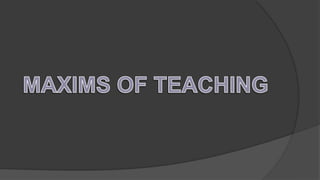
Maxims of teaching ppt
- 2. Introduction • Teaching is an art & a science. Teacher require two things – Knowledge & Process of teaching. • In actual classroom, teacher required to manage the class with experience & decisions in form of Maxims. For successful & effective teaching , teacher must know & use maxims of teaching.
- 3. Meaning of maxims of teaching Maxims are nothing but simple guidelines or principles which help the teachers to take decisions and act accordingly during the teaching process. Maxims are zest of experience of experience teacher. These maxims have been formulated by the psychologists, educationists, pedagogues and preceptors on the basis of their experiences. These maxims are reliable and are universally applicable. Maxims of teaching act as the springboard which catalyzes the momentum of teaching learning process and thus helps the teacher in achieving the pre- determined objectives of education besides providing contentment to both the learners as well as the teachers.
- 4. Definition of Maxims According to Richard, “Teacher’s maxims appear to reflect cultural factors, belief systems, experience, training and the understanding of which maxims teachers give priority and how they influence teachers’ practices is an important goal in teacher development”
- 5. Different Maxims of Teaching From known to Unknown. From simple to Complex. From seen to Unseen. From concrete to Abstract. From particular to General. From whole to Part. From indefinite to Definite. From psychological to Logical. From Empirical to Rational From Analysis to Synthesis.
- 6. From Know to Unknown This maxim states that the new knowledge to be given to pupils must be logically linked with their previous knowledge. The maxim facilitates learning process and economizes the efforts of the teacher and the taught. It won’t be an exaggeration to say that this maxim is an indispensable part of teaching –learning process. It is a natural method of learning. Known is trustworthy and unknown cannot be trusted so while teaching we should proceed from known and go towards unknown. EX: Buying and selling (known) Profit and loss (unknown)
- 7. From simple to complex • In this process of teaching –learning, the teacher should see those simple things are presented first to the students. That way they will start taking an interest. Once they become interested, thou gradually complex type of things can also be learnt by them. By learning simple things, they feel encouraged and they also gain confidence. On this basis, they become further receptive to the complex matter. What is simple in teacher’s view is not necessarily similar for students. It can be vice-versa too. Thus, keeping in view students ability, attitude, potentiality and interest, simple tasks should be fixed. EX: First simple interest and then compound interest
- 8. From concrete to abstract • Concrete things are solid things and they can be visualized and verified by Five Senses. But abstract things are only imaginative things and are therefore difficult to understand. • In general, tangible entities are grouped under concrete objects while intangible entities are grouped under abstract objects. • Application of this maxim helps the learners understand the materials more easily. Some power of imagination also develops in them. • An able and skilled teacher educator can employ this maxim of teaching in the following: Live demonstration of different teaching skills before pupil-teachers. Demonstration of apparatus and instruments used in Psychology laboratory, Science laboratory, Mathematics laboratory, ICT laboratory, Art &craft laboratory, etc,. Ex: teach first Sun , Moon and Stars then teach planets, satellites etc..
- 9. From Particular to General From particular statement, specific concept or subject matter to more generalised principles. Ex: the sum of all angles in triangle is 3600 (General). In all the triangles the sum of all angles are 3600 (particular).
- 10. From Analysis to synthesis Analysis means breaking a problem into its convenient parts . Synthesis is just reverse of Analysis. While synthesis means grouping of these separated parts into one whole. In other words in analysis the subject broken into its components or elements while in synthesis the scattered elements of the subject are collected and the clarification of these elements is logically presented. The complex topic or subjects need to be taught in a logical and systematic manner. Ex: Teaching about the digestive system of a Frog. Student should first know how to dissect a frog. Analyse each part of the digestive system.
- 11. From Psychological to Logical While teaching the teacher should first keep in mind the interest, aptitude, capacities, development level etc. of the children during the selection of subject matter and then on to its logical arrangement. Individual differences of the learners should also be kept in mind This maxim states that the sequence of teaching process should be psychological followed by logical. If the teaching process is not in logical order and its organization is not systematic the entire teaching process with become either hotchpotch or haphazard.
- 12. From Empirical to Rational Empirical Knowledge is based on verifiable observable experiences. It is based on results and observations. Rational Knowledge is based on reasons and logic. Only reasoning and reflections can be used as evidence to prove. Ex: Rules and norms (Empirical) Values and Ethics (Rational)
- 13. From Induction to Deduction In the inductive approach, we start from particular examples and establish general rules through the active participation of the learners. In the deductive approach we assume a definition, a general rules or formula and apply it to particular example. Teaching should proceed from induction to deduction
- 14. Benefits of Maxims of teaching • Simplify the process of teaching. • Joyful teaching & learning environment. • Purposeful teaching • To create creativity among students • To analysis & synthesis by students • To develop scientific attitude • Learning by doing • To develop critical thinking.